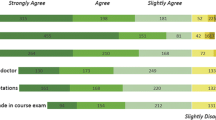Abstract
Modern integrated medical curricula usually do not include a separate pathology course. Consequently, there is a risk that important pathological principles may be omitted. We aimed to ensure that pathology is properly represented by developing a core pathology curriculum created in consultation with local pathologists. Appropriate information technology to track the delivery of this material within the integrated curriculum structure was developed using a learning content management system in which a metadata schema was constructed. This allows a sophisticated view of where and how pathology appears in the course and can also increase the visibility of the subject by demonstrating the central place of pathology in medicine. In conclusion, a core curriculum in pathology that can be tracked by information technology with sufficient power and flexibility is a solution to the potential loss of pathology from integrated medical courses. We believe the result is superior to a stand-alone pathology course.
Similar content being viewed by others
References
Du Boulay C (1997) Learning pathology: why? how? when. J Clin Pathol 50:623–624
Australian Medical Council (2008) Goals and objectives of basic medical education. http://www.amc.org.au/accredgoals.asp Accessed 21 Apr 2008
General Medical Council (2002) Tomorrow’s doctors: Recommendations on undergraduate medical education. GMC, London, p 6
Weedon D (2003) Whither pathology in medical education. Med J Aust 178:200–202
Royal College of Pathologists of Australasia (2003) Learning objectives for pathology in medical curricula. RCPA, Surry Hills, pp 3–9
Mattick K, Marshall R, Bligh J (2004) Tissue pathology in undergraduate medical education: atrophy or evolution. J Pathol 203:871–876
Albanese M, Mitchell S (1993) Problem based learning - a review of the literature on its outcomes and implementation. Acad Med 68:52–81
Bligh J (2000) Problem based learning - the story continues to unfold. Med Educ 34:688–689
Vernon D, Blake R (1993) Does problem based learning work? A meta-analysis of evaluative research. Acad Med 68:550–563
Bouhuijs PAJ, Schmidt HG, Berkel H (1993) Problem-based learning as an educational strategy. Network, Maastricht
Vernon-Roberts B, Cleary EG, Vernon-Roberts J (1997) Graded check lists to assist undergraduate students in self-directed learning and assessment in general and systematic anatomical pathology. Pathology 29:370–373
United States National Library of Medicine (2004) NLM metadata schema. http://www.nlm.nih.gov/tsd/cataloging/metafilenew.html Accessed 8 Aug 2008
Harden RM (2001) AMEE Guide No. 21: Curriculum mapping: a tool for transparent and authentic teaching and learning. Med Teach 23:123–137
Odell EW, Farthing PM, High A et al (2004) British Society for Oral and Maxillofacial Pathology, UK: minimum curriculum in oral pathology. Eur J Dent Educ 8:177–184
Dick F, Leaven T, Dillman D et al (1998) Core morphological concepts of disease for second-year medical students. Hum Pathol 29:1017–1020
Allen CM (1996) Oral and maxillofacial pathology: what should we teach and how should we teach it. Oral Surg Oral Med Oral Pathol 82:235
Domizio P, du Boulay C (2006) Working smarter. Career choices and career progression in the pathology specialties: national surveys of UK medical graduates. Bull Royal Coll Pathol 134:31–35
Marshall R, Cartwright N, Mattick K (2004) Teaching and learning pathology: a critical review of the English literature. Med Educ 38:302–313
Conflict of Interest Statement
We declare that we have no conflict of interest.
Author information
Authors and Affiliations
Corresponding author
Electronic supplementary material
Below is the link to the electronic supplementary material.
Supplementary Fig. 1.
Top left: A list of the 93 clinical problems around which the curriculum is arranged. Clicking on one of these (47. Chest Pain) displays the Problem Blueprint shown to the right. Right: Blueprint for problem 47. It shows the learning outcomes covered under each of the four themes. It also shows the science specialties (including pathology), clinical specialties, body systems and differential diagnoses to which this problem relates. Students can then move from this ‘micro’ view back to a ‘macro’ view listing other problems on various criteria. Clicking on the icons to the right displays resources and learning activities matching that learning outcome and the problem. Clicking on one of the specialties or body systems shows a list of problems related to it. For example, a list of other problems covering pathology as a specialty can be shown by simply clicking on the ‘Pathology, Anatomical & Clinical’. Below: A list of problems related to pathology (from another blueprint). Students could now click on another problem and move from the macro to the micro view into another blueprint, and so on (GIF 358 MB).
Supplementary Fig. 2.
Learning activity search. This screen allows students and staff to navigate through the ‘curriculum web’. The screenshot shows anatomical pathology already selected; the search is further refined by selecting components of the other descriptors. The search will lead to specific learning activities (GIF 605 KB).
Supplementary Fig. 3.
Science specialty coverage visualisation. This display shows the coverage of science specialties for the first year in the course. The vertical axis displays the two-weekly body system curriculum blocks. Each fortnight is represented by a box, the brightness of which indicates the number of learning activities mapping to each specialty. For example, pathology (fifth column from the right) is particularly strongly represented in the fortnight designated ‘CVSR 3–4’ (the third and fourth weeks of the Cardiovascular/Respiratory body system block) (GIF 208 KB).
Rights and permissions
About this article
Cite this article
Carr, N.J., Olmos, M. & Bushnell, J. Delivering a pathology curriculum in an integrated medical course. Virchows Arch 453, 369–375 (2008). https://doi.org/10.1007/s00428-008-0666-x
Received:
Revised:
Accepted:
Published:
Issue Date:
DOI: https://doi.org/10.1007/s00428-008-0666-x




